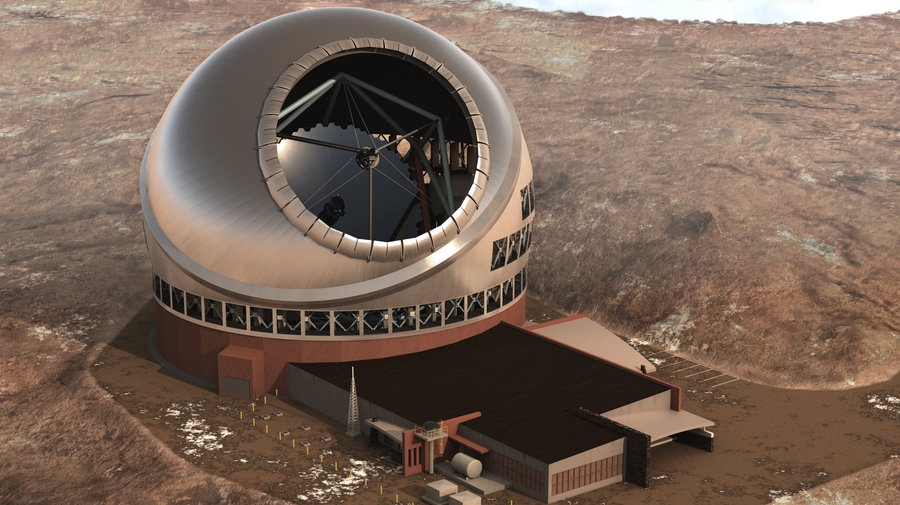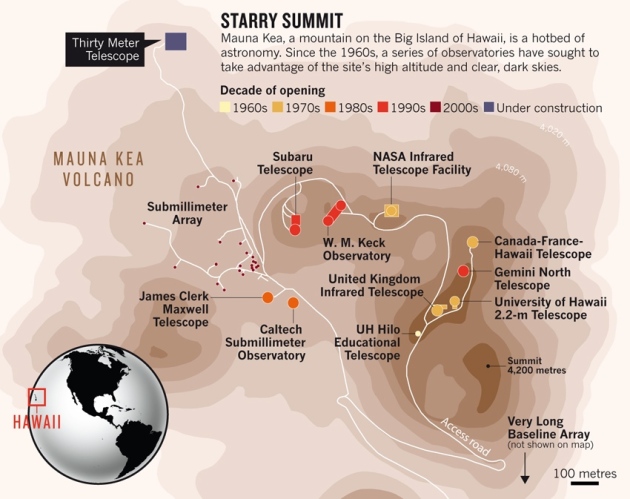Soheil_Esy
Fazanavard فضانورد
- Joined
- Apr 5, 2015
- Messages
- 744
- Reaction score
- 19
- Points
- 18
Decision throws construction of the Thirty Meter Telescope into question.
03 December 2015
Hawaii's supreme court has ruled that the construction permit for the Thirty Meter Telescope (TMT) on top of the mountain Mauna Kea is invalid. The 2 December decision is a major blow to the international consortium backing the US$1.5-billion telescope, and a win for the Native Hawaiians who have protested against its construction on what they regard as a sacred summit.
Hawaii's Board of Land and Natural Resources should not have approved the permit in 2011, the court said, because it did so before protestors could air their side in a contested case hearing. “Quite simply, the Board put the cart before the horse when it issued the permit,” the court decision reads. “Accordingly, the permit cannot stand.”
"TMT will follow the process set forth by the state, as we always have," TMT board chair Henry Yang said in a statement. "We are assessing our next steps on the way forward."
Construction blocked
It is unclear whether and how the TMT will move forward given the new ruling. Work on the telescope's components has continued at sites outside Hawaii, but the court's decision to block the construction permit is a significant setback. To proceed, the project would have to acquire another permit from the board.
Part of the planned TMT site, just below Mauna Kea's 4,200-metre summit, has been cleared, and construction was to have begun last April. But those plans are on hold as protestors have blocked the roads to the site and pursued legal avenues to halt the project.
The TMT would be the Northern Hemisphere counterpart to two other next-generation telescopes, the European Extremely Large Telescope and the Giant Magellan Telescope, now under construction in Chile.
Culture clash
But the TMT faces unique battles at Mauna Kea, which many Native Hawaiians have long argued should not be desecrated by astronomical observatories. Thirteen observatories — one with multiple telescopes — currently sit on the mountain in a science reserve operated by the University of Hawaii. One existing telescope is being dismantled and two others are slated for decommissioning, after the fight over the TMT accelerated plans to limit development on the mountain top.
Because the mountain pokes out from the middle of the Pacific Ocean, the skies above Mauna Kea are among the clearest in the world. Some Native Hawaiians say that the benefits to astronomy do not outweigh the need to respect and protect the natural and cultural environment. Many took to social media to praise the court's decision.
TMT's partners are the University of California and the California Institute of Technology, along with research entities from the governments of Canada, China, India and Japan.

An artist's rendering of the yet-unbuilt Thirty Meter Telescope

http://www.nature.com/news/hawaiian...ega-telescope-1.18944?WT.mc_id=TWT_NatureNews
Commentary
03 December 2015
Hawaii's supreme court has ruled that the construction permit for the Thirty Meter Telescope (TMT) on top of the mountain Mauna Kea is invalid. The 2 December decision is a major blow to the international consortium backing the US$1.5-billion telescope, and a win for the Native Hawaiians who have protested against its construction on what they regard as a sacred summit.
Hawaii's Board of Land and Natural Resources should not have approved the permit in 2011, the court said, because it did so before protestors could air their side in a contested case hearing. “Quite simply, the Board put the cart before the horse when it issued the permit,” the court decision reads. “Accordingly, the permit cannot stand.”
"TMT will follow the process set forth by the state, as we always have," TMT board chair Henry Yang said in a statement. "We are assessing our next steps on the way forward."
Construction blocked
It is unclear whether and how the TMT will move forward given the new ruling. Work on the telescope's components has continued at sites outside Hawaii, but the court's decision to block the construction permit is a significant setback. To proceed, the project would have to acquire another permit from the board.
Part of the planned TMT site, just below Mauna Kea's 4,200-metre summit, has been cleared, and construction was to have begun last April. But those plans are on hold as protestors have blocked the roads to the site and pursued legal avenues to halt the project.
The TMT would be the Northern Hemisphere counterpart to two other next-generation telescopes, the European Extremely Large Telescope and the Giant Magellan Telescope, now under construction in Chile.
Culture clash
But the TMT faces unique battles at Mauna Kea, which many Native Hawaiians have long argued should not be desecrated by astronomical observatories. Thirteen observatories — one with multiple telescopes — currently sit on the mountain in a science reserve operated by the University of Hawaii. One existing telescope is being dismantled and two others are slated for decommissioning, after the fight over the TMT accelerated plans to limit development on the mountain top.
Because the mountain pokes out from the middle of the Pacific Ocean, the skies above Mauna Kea are among the clearest in the world. Some Native Hawaiians say that the benefits to astronomy do not outweigh the need to respect and protect the natural and cultural environment. Many took to social media to praise the court's decision.
TMT's partners are the University of California and the California Institute of Technology, along with research entities from the governments of Canada, China, India and Japan.

An artist's rendering of the yet-unbuilt Thirty Meter Telescope

http://www.nature.com/news/hawaiian...ega-telescope-1.18944?WT.mc_id=TWT_NatureNews
Commentary
As this project was the first large size telescope project for both China and India and also their first scientific cooperation, it will be an opportunity for both Asian great powers to relocate the future Thirty Meter Telescope project in the Himalayas on their common border. Japan is of course invited to join.
A beautiful new location for the TMT:
Himalayan Indian Astronomical Observatory (IAO)

Located in the remotest location in the Himalayan Mountains, the Indian Astronomical Observatory (IAO) (longitude 78◦57’510” E; latitude 32◦46’46” N) is one of the highest sites for optical, infra red and gamma ray telescopes. Situated at a height of 14,746 feet above mean sea level, the IAO houses the Himalayan Chandra telescope (HCT), a 2.01 meter Optical, Infra-red telescope that continuously monitors the night sky, making it the second highest telescope in the world, after the University of Tokyo Atacama Observatory (TAO).
The Himalayan Chandra Telescope, named after the famous astrophysicist Dr. S Chandrasekhar stands on Mt. Saraswati in the vast Nilamkhul Plain in the Hanle Valley in the Changthang region. Accessing the observatory that is located to the close proximity of the Chinese border, requires eight hours drive from Leh, the district capital of Ladakh.
This remote site was chosen in the early 90’s, owing to its dry, cold desert, cloudless skies and low atmospheric water vapour content making it one of the best place for doing optical, infrared, sub millimetre, millimetre and gamma ray astronomy.






http://astroproject.in/himalayan-chandra-telescope-iao-hanle/
S☫heil_Esy
Last edited:
